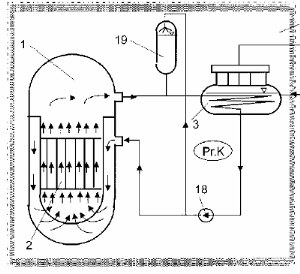Corrosion product transport in nuclear reactors
New radioanalytical technique has been developed and applied for controlling corrosion processes in the primary circuit of nuclear reactors. 55Fe, 63Ni and 60Co activities were determined by the Combined analytical procedure I. Corrosion particles were taken from the coolant, from the fuel element surfaces and from the steam generator tubes.

Specific activities were determined from measured activity and elemental concentration data. Supposing cyclic activation of the circulating particles average retention times of the particles in the reactor core were calculated. Retention times varied between a couple of days and several months and were basically influenced by the origin of the particle.
Particles taken from the steam generators or from the coolant seem to have spent short times in the core while particles originating from fuel cladding show long retention times. It can be concluded that the corrosion product transport is directed to the core, release of activated corrosion products into the coolant as well as deposition on the steam generators is limited. These conditions have to be maintained by good operation practice!
Further studies are in progress to determine the dependence of the specific activities on the operation mode of the reactor (stable or transient), and to reveal differences among reactor units.
